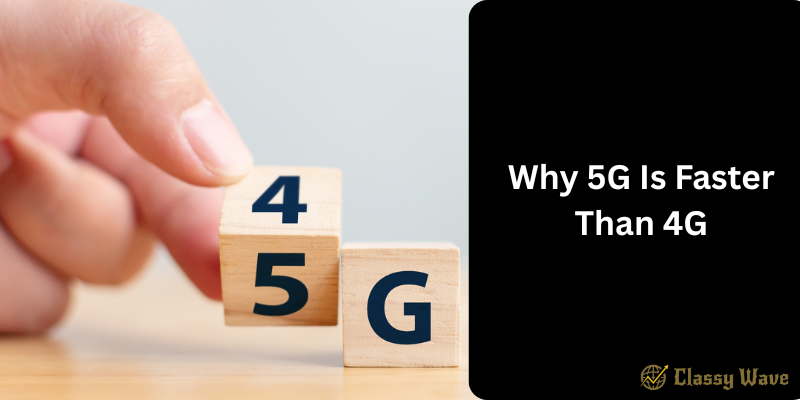Why 5G Is Faster Than 4G | Classy Wave
We’ve come a long way from the days of 2G and 3G. The leap from 4G to 5G is not just an upgrade—it’s a complete transformation in how we connect and communicate. You’ve probably heard that 5G is much faster than 4G, but why exactly is that? What makes 5G so powerful that it can download an entire HD movie in seconds? Let’s break it down in simple terms.
Understanding the Basics: 4G vs 5G
Before diving into the technical side, let’s understand what 4G and 5G actually mean.
- 4G (Fourth Generation) networks brought us mobile internet speeds fast enough for streaming videos, browsing, and social media.
- 5G (Fifth Generation) takes this to the next level, offering ultra-fast speeds, near-instant communication, and support for billions of connected devices at once.
In essence, 5G is not just about speed—it’s about efficiency, capacity, and real-time connectivity.
1. Higher Frequency Bands
One of the main reasons 5G is faster than 4G is its use of higher frequency bands, known as millimeter waves (mmWave).
- 4G networks use lower frequencies between 700 MHz and 2.6 GHz.
- 5G networks can operate up to 100 GHz.
Higher frequencies can carry more data, which means faster transmission. Think of it like widening a highway—more lanes allow more cars (data) to move quickly.
2. Wider Bandwidth
Bandwidth determines how much data can be transferred at once.
- 4G typically uses 20 MHz of bandwidth.
- 5G can use up to 100 MHz, or even 400 MHz in some cases.
This wider bandwidth allows 5G to transmit a larger volume of information simultaneously, resulting in dramatically faster download and upload speeds.
3. Advanced Antenna Technology (Massive MIMO)
5G networks use a technology called Massive MIMO (Multiple Input Multiple Output).
While 4G uses up to a dozen antennas, 5G can use hundreds of small antennas to send and receive signals.
This multi-antenna setup helps 5G handle more users at once while improving signal strength and stability. Imagine it as having multiple doorways to let people in and out quickly—no traffic jams.
4. Low Latency Communication
Latency is the delay between sending and receiving data.
- 4G latency: Around 30–50 milliseconds
- 5G latency: As low as 1 millisecond
That’s almost instantaneous! This ultra-low latency makes 5G ideal for real-time applications like autonomous driving, remote surgery, and virtual reality (VR).
Less delay means smoother experiences for users—no buffering, lag, or interruptions.
5. Network Slicing
5G introduces a new concept called network slicing, which allows one physical network to be divided into multiple virtual networks.
For example:
- One slice for streaming videos
- Another for smart cars
- Another for emergency services
Each slice can be optimized for specific needs, ensuring high speed and reliability for every type of use. 4G simply can’t do that.
6. Beamforming Technology
Beamforming is another breakthrough that makes 5G faster.
Instead of broadcasting signals in all directions (like 4G), 5G focuses its signal directly toward your device.
This precision targeting improves both speed and efficiency, as the data reaches your phone faster and with less interference—like a spotlight shining directly where it’s needed.
7. Increased Device Capacity
5G can support up to 1 million devices per square kilometer, while 4G can only handle about 100,000.
That means 5G can manage heavy traffic in crowded areas like stadiums, concerts, and cities without slowing down. More connected devices don’t affect performance like they did with 4G.
8. Edge Computing
5G networks integrate edge computing, which brings data processing closer to the user instead of relying on distant cloud servers.
This reduces the time it takes for data to travel, improving response speed.
It’s like having a mini data center right in your city rather than across the country—faster access, quicker results.
9. Smarter Network Design
5G networks are built on software-defined architecture, meaning they are more flexible and intelligent. They can automatically adapt to different demands, allocate resources efficiently, and balance data traffic in real time.
This adaptability ensures that users always get the best speed possible based on network conditions.
10. Real-World Speed Difference
To put it simply:
- 4G average speed: 20–100 Mbps
- 5G average speed: 1–10 Gbps (that’s up to 100 times faster!)
With 5G, you can download a full HD movie in under 10 seconds, compared to several minutes on 4G. Streaming in 4K, online gaming, and video calls all become smoother and lag-free.
11. Energy Efficiency
Interestingly, 5G isn’t just faster—it’s also more energy-efficient. It transmits data more intelligently, which helps devices save battery and networks use less power per bit of data. That means longer battery life for your phone and a greener, more sustainable network overall.
12. Better Support for Future Technology
5G’s superior speed and reliability pave the way for emerging technologies like:
- Self-driving cars
- Smart homes and cities
- Augmented and virtual reality (AR/VR)
- AI-powered automation
These innovations need near-instant communication, something only 5G can deliver effectively.
Conclusion
5G is faster than 4G because it’s built on smarter, more advanced technology. From higher frequencies and wider bandwidth to beamforming and edge computing, every aspect of 5G is designed for speed, efficiency, and reliability. It’s not just about faster downloads—it’s about transforming how we live, work, and connect.
As 5G continues to expand globally, we’re stepping into an era where everything—cars, homes, and even cities—will communicate seamlessly in real-time.







